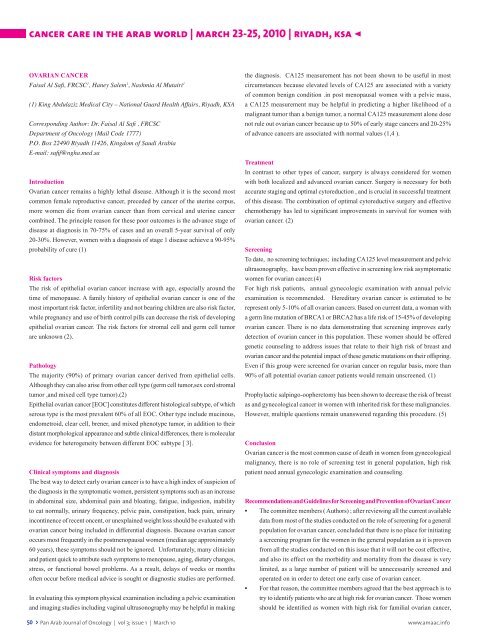Pan Arab Journal of Oncology - Arab Medical Association Against ...
Pan Arab Journal of Oncology - Arab Medical Association Against ...
Pan Arab Journal of Oncology - Arab Medical Association Against ...
Create successful ePaper yourself
Turn your PDF publications into a flip-book with our unique Google optimized e-Paper software.
cancer care in the arab world | march 23-25, 2010 | riyadh, ksa <<br />
OVARIAN CANCER<br />
Faisal Al Safi, FRCSC 1 , Haney Salem 1 , Nashmia Al Mutairi 1<br />
(1) King Abdulaziz <strong>Medical</strong> City – National Guard Health Affairs, Riyadh, KSA<br />
Corresponding Author: Dr. Faisal Al Safi , FRCSC<br />
Department <strong>of</strong> <strong>Oncology</strong> (Mail Code 1777)<br />
P.O. Box 22490 Riyadh 11426, Kingdom <strong>of</strong> Saudi <strong>Arab</strong>ia<br />
E-mail: safif@ngha.med.sa<br />
Introduction<br />
Ovarian cancer remains a highly lethal disease. Although it is the second most<br />
common female reproductive cancer, preceded by cancer <strong>of</strong> the uterine corpus,<br />
more women die from ovarian cancer than from cervical and uterine cancer<br />
combined. The principle reason for these poor outcomes is the advance stage <strong>of</strong><br />
disease at diagnosis in 70-75% <strong>of</strong> cases and an overall 5-year survival <strong>of</strong> only<br />
20-30%. However, women with a diagnosis <strong>of</strong> stage 1 disease achieve a 90-95%<br />
probability <strong>of</strong> cure (1)<br />
Risk factors<br />
The risk <strong>of</strong> epithelial ovarian cancer increase with age, especially around the<br />
time <strong>of</strong> menopause. A family history <strong>of</strong> epithelial ovarian cancer is one <strong>of</strong> the<br />
most important risk factor, infertility and not bearing children are also risk factor,<br />
while pregnancy and use <strong>of</strong> birth control pills can decrease the risk <strong>of</strong> developing<br />
epithelial ovarian cancer. The risk factors for stromal cell and germ cell tumor<br />
are unknown (2).<br />
Pathology<br />
The majority (90%) <strong>of</strong> primary ovarian cancer derived from epithelial cells.<br />
Although they can also arise from other cell type (germ cell tumor,sex cord stromal<br />
tumor ,and mixed cell type tumor).(2)<br />
Epithelial ovarian cancer [EOC] constitutes different histological subtype, <strong>of</strong> which<br />
serous type is the most prevalent 60% <strong>of</strong> all EOC. Other type include mucinous,<br />
endometroid, clear cell, brener, and mixed phenotype tumor, in addition to their<br />
distant morphological appearance and subtle clinical differences, there is molecular<br />
evidence for heterogeneity between different EOC subtype [ 3].<br />
Clinical symptoms and diagnosis<br />
The best way to detect early ovarian cancer is to have a high index <strong>of</strong> suspicion <strong>of</strong><br />
the diagnosis in the symptomatic women, persistent symptoms such as an increase<br />
in abdominal size, abdominal pain and bloating, fatigue, indigestion, inability<br />
to eat normally, urinary frequency, pelvic pain, constipation, back pain, urinary<br />
incontinence <strong>of</strong> recent oncent, or unexplained weight loss should be evaluated with<br />
ovarian cancer being included in differential diagnosis. Because ovarian cancer<br />
occurs most frequently in the postmenopausal women (median age approximately<br />
60 years), these symptoms should not be ignored. Unfortunately, many clinician<br />
and patient quick to attribute such symptoms to menopause, aging, dietary changes,<br />
stress, or functional bowel problems. As a result, delays <strong>of</strong> weeks or months<br />
<strong>of</strong>ten occur before medical advice is sought or diagnostic studies are performed.<br />
In evaluating this symptom physical examination including a pelvic examination<br />
and imaging studies including vaginal ultrasonography may be helpful in making<br />
the diagnosis. CA125 measurement has not been shown to be useful in most<br />
circumstances because elevated levels <strong>of</strong> CA125 are associated with a variety<br />
<strong>of</strong> common benign condition .in post menopausal women with a pelvic mass,<br />
a CA125 measurement may be helpful in predicting a higher likelihood <strong>of</strong> a<br />
malignant tumor than a benign tumor, a normal CA125 measurement alone dose<br />
not rule out ovarian cancer because up to 50% <strong>of</strong> early stage cancers and 20-25%<br />
<strong>of</strong> advance cancers are associated with normal values (1,4 ).<br />
Treatment<br />
In contrast to other types <strong>of</strong> cancer, surgery is always considered for women<br />
with both localized and advanced ovarian cancer. Surgery is necessary for both<br />
accurate staging and optimal cytoreduction , and is crucial in successful treatment<br />
<strong>of</strong> this disease. The combination <strong>of</strong> optimal cytoreductive surgery and effective<br />
chemotherapy has led to significant improvements in survival for women with<br />
ovarian cancer. (2)<br />
Screening<br />
To date, no screening techniques; including CA125 level measurement and pelvic<br />
ultrasonography, have been proven effective in screening low risk asymptomatic<br />
women for ovarian cancer.(4)<br />
For high risk patients, annual gynecologic examination with annual pelvic<br />
examination is recommended. Hereditary ovarian cancer is estimated to be<br />
represent only 5-10% <strong>of</strong> all ovarian cancers. Based on current data, a woman with<br />
a germ line mutation <strong>of</strong> BRCA1 or BRCA2 has a life risk <strong>of</strong> 15-45% <strong>of</strong> developing<br />
ovarian cancer. There is no data demonstrating that screening improves early<br />
detection <strong>of</strong> ovarian cancer in this population. These women should be <strong>of</strong>fered<br />
genetic counseling to address issues that relate to their high risk <strong>of</strong> breast and<br />
ovarian cancer and the potential impact <strong>of</strong> these genetic mutations on their <strong>of</strong>fspring.<br />
Even if this group were screened for ovarian cancer on regular basis, more than<br />
90% <strong>of</strong> all potential ovarian cancer patients would remain unscreened. (1)<br />
Prophylactic salpingo-oopherctomy has been shown to decrease the risk <strong>of</strong> breast<br />
as and gynecological cancer in women with inherited risk for these malignancies.<br />
However, multiple questions remain unanswered regarding this procedure. (5)<br />
Conclusion<br />
Ovarian cancer is the most common cause <strong>of</strong> death in women from gynecological<br />
malignancy, there is no role <strong>of</strong> screening test in general population, high risk<br />
patient need annual gynecologic examination and counseling.<br />
Recommendations and Guidelines for Screening and Prevention <strong>of</strong> Ovarian Cancer<br />
• The committee members ( Authors) ; after reviewing all the current available<br />
data from most <strong>of</strong> the studies conducted on the role <strong>of</strong> screening for a general<br />
population for ovarian cancer, concluded that there is no place for initiating<br />
a screening program for the women in the general population as it is proven<br />
from all the studies conducted on this issue that it will not be cost effective,<br />
and also its effect on the morbidity and mortality from the disease is very<br />
limited, as a large number <strong>of</strong> patient will be unnecessarily screened and<br />
operated on in order to detect one early case <strong>of</strong> ovarian cancer.<br />
• For that reason, the committee members agreed that the best approach is to<br />
try to identify patients who are at high risk for ovarian cancer. Those women<br />
should be identified as women with high risk for familial ovarian cancer,<br />
50 > <strong>Pan</strong> <strong>Arab</strong> <strong>Journal</strong> <strong>of</strong> <strong>Oncology</strong> | vol 3; issue 1 | March 10 www.amaac.info









